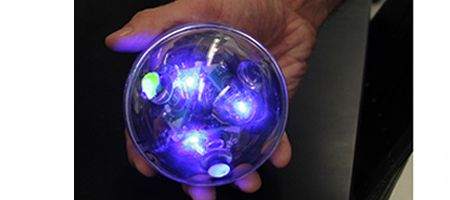Swarms of spherical robots equipped with biogeochemical sensors could soon be cruising the oceans on study missions.

Arizona State University’s Sensorbots are fist-sized transparent spheres, which communicate via brilliant blue flashes of light. The spheres house electronics and batteries, while their surfaces have three sensors for measuring pH, temperature or oxygen.
They report surrounding environmental conditions to the inner electronics which then convert the data into flashes of light, in a sort of visual Morse code.
A high-speed camera situated on the seafloor picks up the signals and stores them for later decoding aboard the ship. Ultimately, says the team, Sensorbots will operate in semi-autonomous robotic swarms, moving under remote control.
Sensor swarms operating autonomously could function in complex, harsh, and remote environments. With appropriate microanalytical systems mounted on the Sensorbot platforms, these synthetic mariners could perform spatially and temporally indexed genomic analyses of microbial communities, as well as observing a broad variety of macro events.
“The Sensorbots will enable continuous spatiotemporal monitoring of key elements in the ocean and the ability to respond to events such as underwater earthquakes and hydrothermal vents,” says professor Deirdre Meldrum.
“Such research is essential for a more thorough understanding of the multiple systems in the oceans—microbes and other sea life, geology, and chemicals.”
The optical signals transmitted by the latest generation of Sensorbots will be linked, using multi-hop networking technologies.
“Rather than delivering a very expensive robot to a single point in space and then serially moving it around, often missing dynamic phenomena, an array of inexpensive Sensorbots can cover a wide field, permitting real-time investigations of earthquakes, biological blooms, and other episodic phenomena,” says assistant research professor Cody Youngbull.
“Networking will allow us to trail sensorbots like a string of pearls over great distances — so we’ll get all the benefits of optical communication speed and energy efficiency without the detriment of optical loss and attenuation in sea water.”






